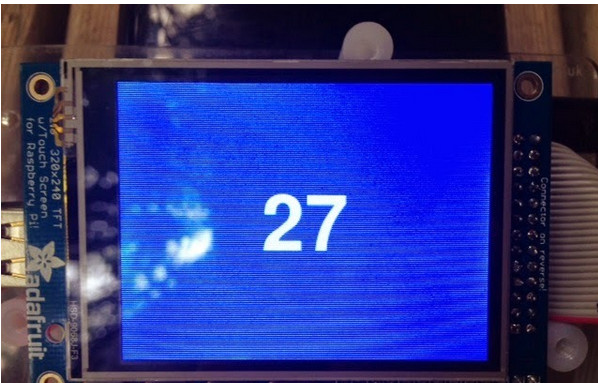RASP-PYGAME-GUI-GPIO
Du GPIO vers l'écran
Nous pouvons maintenant afficher nos couleurs sur l'écran - faisons le aussi depuis les GPIOs!

Crédit: AdaFruit Industries www.adafruit.com
Nous allons utiliser les boutons tactiles qui se trouvent le long de l'écran. Nous allons afficher le N° de GPIO et un fond d'écran coloré.
De la gauche sur la droite (sur ce modèle de PiTFT) les boutons correspondent aux GPIO GPIO #23, #22, #27 et #18. Cette information est également lisible sur la sérigraphie.
(Note: si vous disposez de la révision 1 de la carte alors c'est le GPIO #21 qui est utilisé à la place de #27 - Il vous faudra modifier un peu le code)
Code d'initialisation
The code is split into two sections: le code d'initialisation (dit "startup" en anglais) et la boucle principale (dite "main loop" en anglais). Let's take a look at what's happening during startup.
This first section below imports a few things and then defines a datastructure for the four buttons. It's a simple map from GPIO number to RGB tuple. RGB tuples are used in a lot of pygame calls to set colors for fonts, backgrounds etc.
With the button map in place we can now loop through this and setup all the GPIOs. Each one needs to be set to an input with a pull-up since the buttons are connected to ground.
Finally in this startup section we initialise pygame. The os.putenv call here is setting up an environment variable for SDL to tell it which frame buffer device we want to use. We then initialise pygame, hide the mouse pointer, set the display size and fill the background in black.
import pygame
import os
from time import sleep
import RPi.GPIO as GPIO
#Note #21 changed to #27 for rev2 Pi
button_map = {23:(255,0,0), 22:(0,255,0), 27:(0,0,255), 18:(0,0,0)}
#Setup the GPIOs as inputs with Pull Ups since the buttons are connected to GND
GPIO.setmode(GPIO.BCM)
for k in button_map.keys():
GPIO.setup(k, GPIO.IN, pull_up_down=GPIO.PUD_UP)
#Colours
WHITE = (255,255,255)
os.putenv('SDL_FBDEV', '/dev/fb1')
pygame.init()
pygame.mouse.set_visible(False)
lcd = pygame.display.set_mode((320, 240))
lcd.fill((0,0,0))
pygame.display.update()
font_big = pygame.font.Font(None, 100)
La boucle principale
Here we scan through the GPIOs to see if the buttons are pressed. We simply loop over the map we created earlier pulling out the GPIO number and the RGB tuple into k and v. If the GPIO is set False then the button is down. In which case we fill the background with the color referenced by v and then draw the text of the GPIO number.
Note the sleep(0.1) call at the end of the loop. This simply ensures that our program is yielding and not running at 100% CPU usage.
while True:
# Scan the buttons
for (k,v) in button_map.items():
if GPIO.input(k) == False:
lcd.fill(v)
text_surface = font_big.render('%d'%k, True, WHITE)
rect = text_surface.get_rect(center=(160,120))
lcd.blit(text_surface, rect)
pygame.display.update()
sleep(0.1)
Exécuter le projet
You can also run this from the pygamelcd project:
Source: Raspberry Pi Pygame UI basics créé par by Jeremy Blythe pour www.adafruit.com
Traduit par Meurisse D. pour MCHobby SPRL Toute référence, mention ou extrait de cette traduction doit être explicitement accompagné du texte suivant : « Traduction par MCHobby (www.MCHobby.be) - Vente de kit et composants » avec un lien vers la source (donc cette page) et ce quelque soit le média utilisé.
L'utilisation commercial de la traduction (texte) et/ou réalisation, même partielle, pourrait être soumis à redevance. Dans tous les cas de figures, vous devez également obtenir l'accord du(des) détenteur initial des droits. Celui de MC Hobby s'arrêtant au travail de traduction proprement dit.
Traduit avec l'autorisation d'AdaFruit Industries - Translated with the permission from Adafruit Industries - www.adafruit.com